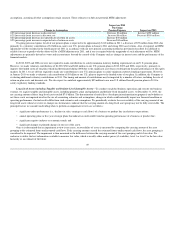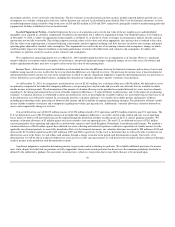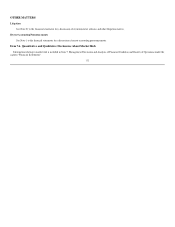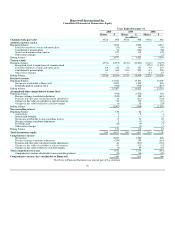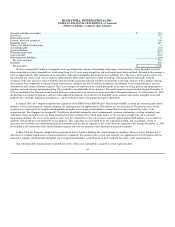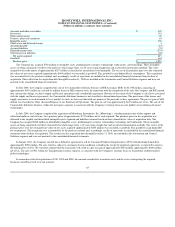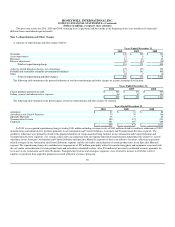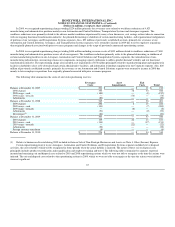Honeywell 2010 Annual Report Download - page 60
Download and view the complete annual report
Please find page 60 of the 2010 Honeywell annual report below. You can navigate through the pages in the report by either clicking on the pages listed below, or by using the keyword search tool below to find specific information within the annual report.
HONEYWELL INTERNATIONAL INC.
NOTES TO FINANCIAL STATEMENTS
(Dollars in millions, except per share amounts)
Note 1—Summary of Significant Accounting Policies
Accounting Principles—The financial statements and accompanying notes are prepared in accordance with accounting principles generally accepted in
the United States of America. The following is a description of the significant accounting policies of Honeywell International Inc.
Principles of Consolidation—The consolidated financial statements include the accounts of Honeywell International Inc. and all of its subsidiaries and
entities in which a controlling interest is maintained. Our consolidation policy requires equity investments that we exercise significant influence over but do
not control the investee and are not the primary beneficiary of the investee's activities to be accounted for using the equity method. Investments through which
we are not able to exercise significant influence over the investee and which we do not have readily determinable fair values are accounted for under the cost
method. All intercompany transactions and balances are eliminated in consolidation.
Cash and Cash Equivalents—Cash and cash equivalents include cash on hand and on deposit and highly liquid, temporary cash investments with an
original maturity of three months or less.
Inventories—Inventories are valued at the lower of cost or market using the first-in, first-out or the average cost method and the last-in, first-out (LIFO)
method for certain qualifying domestic inventories.
Investments—Investments in affiliates over which we have a significant influence, but not a controlling interest, are accounted for using the equity
method of accounting. Other investments are carried at market value, if readily determinable, or at cost. All equity investments are periodically reviewed to
determine if declines in fair value below cost basis are other-than-temporary. Significant and sustained decreases in quoted market prices or a series of historic
and projected operating losses by investees are strong indicators of other-than-temporary declines. If the decline in fair value is determined to be other-than-
temporary, an impairment loss is recorded and the investment is written down to a new carrying value.
Property, Plant and Equipment—Property, plant and equipment are recorded at cost, including any asset retirement obligations, less accumulated
depreciation. For financial reporting, the straight-line method of depreciation is used over the estimated useful lives of 10 to 50 years for buildings and
improvements and 2 to 16 years for machinery and equipment. Recognition of the fair value of obligations associated with the retirement of tangible long-
lived assets is required when there is a legal obligation to incur such costs. Upon initial recognition of a liability, the cost is capitalized as part of the related
long-lived asset and depreciated over the corresponding asset's useful life. See Note 11 and Note 17 for additional details.
Goodwill and Indefinite-Lived Intangible Assets—Goodwill represents the excess of acquisition costs over the fair value of tangible net assets and
identifiable intangible assets of businesses acquired. Goodwill and certain other intangible assets deemed to have indefinite lives are not amortized. Intangible
assets determined to have definite lives are amortized over their useful lives. Goodwill and indefinite lived intangible assets are subject to impairment testing
annually as of March 31, or whenever events or changes in circumstances indicate that the carrying amount may not be fully recoverable. This testing
compares carrying values to fair values and, when appropriate, the carrying value of these assets is reduced to fair value. We completed our annual goodwill
impairment test as of March 31, 2010 and determined that there was no impairment as of that date. See Note 12 for additional details on goodwill balances.
Other Intangible Assets with Determinable Lives—Other intangible assets with determinable lives consist of customer lists, technology, patents and
trademarks and other intangibles and are amortized over their estimated useful lives, ranging from 2 to 24 years.
Long-Lived Assets—We periodically evaluate the recoverability of the carrying amount of long-lived assets (including property, plant and equipment
and intangible assets with determinable lives) whenever events or changes in circumstances indicate that the carrying amount of an asset may not be fully
recoverable. We evaluate events or changes in circumstances based on a number of factors including operating results, business plans and forecasts, general
and industry trends and, economic projections and anticipated cash flows. An impairment is assessed when the undiscounted expected future cash flows
derived from an asset are less than its carrying amount. Impairment losses are measured as the amount by which the carrying value of an asset exceeds its fair
value and are recognized in earnings. We also continually evaluate the estimated useful lives of all long-lived assets and periodically revise such estimates
based on current events.
Sales Recognition—Product and service sales are recognized when persuasive evidence of an arrangement exists, product delivery has occurred or
services have been rendered, pricing is fixed or determinable, and collection is reasonably assured. Service sales, principally representing repair, maintenance
and engineering activities in our Aerospace and Automation and Control Solutions segments, are recognized over
57




